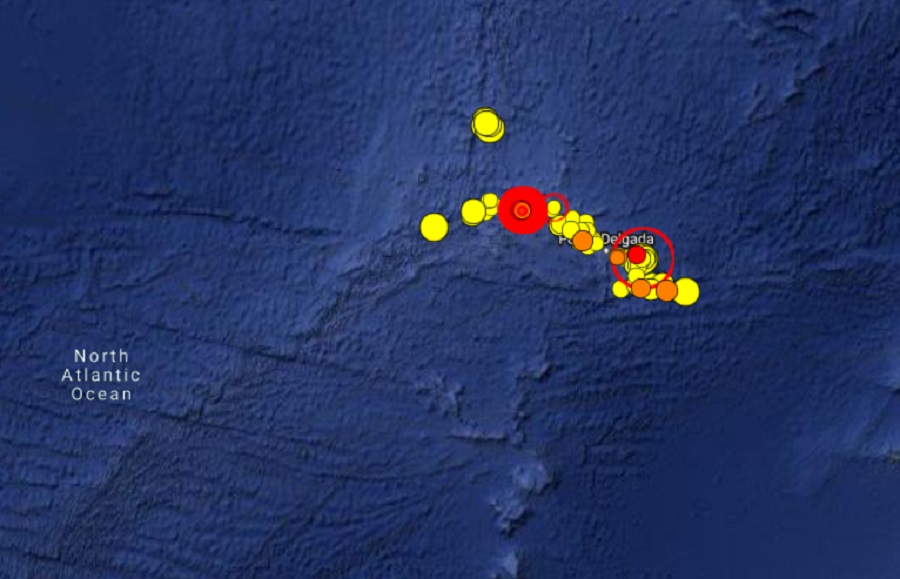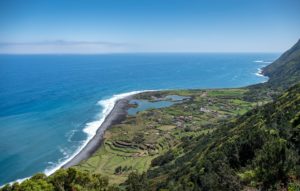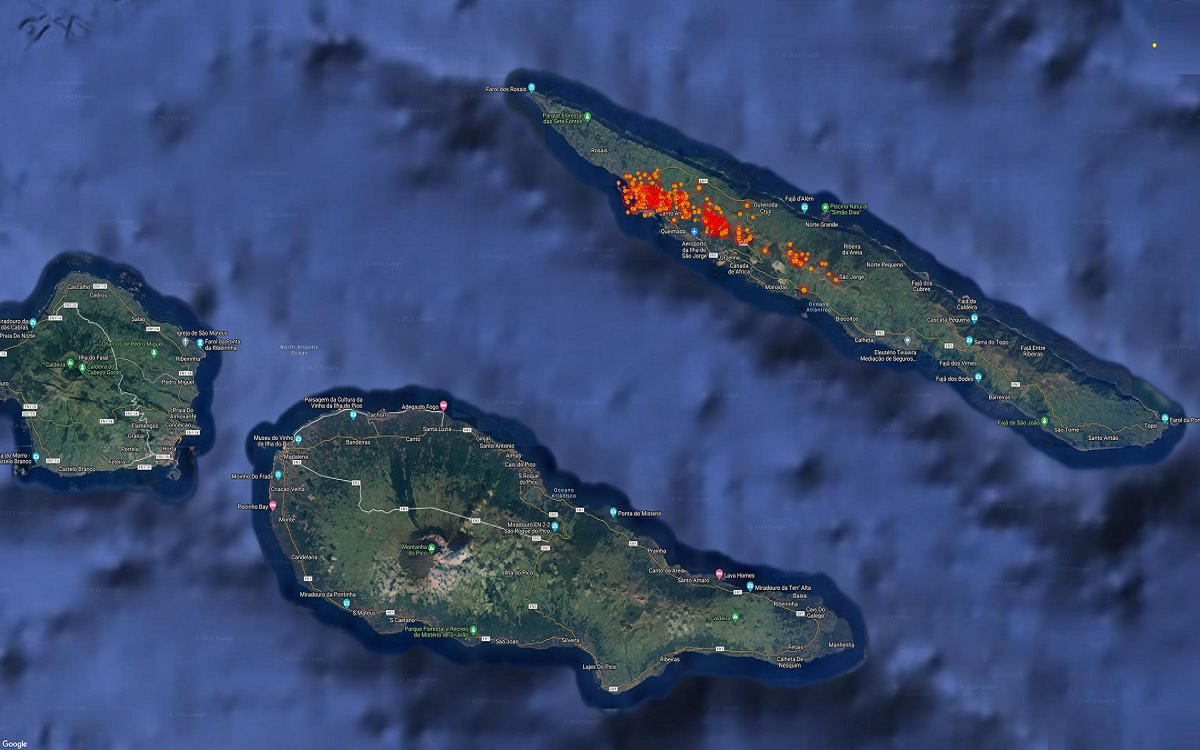
Unusual seismic signals shaking the Azores Islands in the North Atlantic Ocean could be a sign that a new volcanic eruption could be forming. More than 1,100 earthquakes have struck the island of Sāo Jorge, 1 of 9 islands that make up the Azores. With the threat of a volcanic eruption possible, Velas Mayor Luis Silveira, who presides over the area where most of Sāo Jorge’s population lives, activated an emergency plan yesterday. The day before on Sunday, the regional Civil Protection authority said it reached out to mayors and fire departments on the island to “remain vigilant” and help the people of São Jorge if a volcanic eruption does occur. Scientists are drawing parallels between this swarm of earthquakes with a sudden swarm of earthquakes that occured last year on Spain’s La Palma island within the Canary Islands, which is located roughly 870 miles southeast of the Azores; that swarm was followed by a destructive volcanic eruption that persisted much of last year, covering a significant area with lava and/or volcanic ash and cinders. While there’s fears that a destructive volcano can soon erupt, there are also fears that there’d be an Atlantic-wide tsunami; however, USGS and other outlets are quick to point out that such a scenario is unlikely to occur.

Sāo Jorge Island within the Azores is only 33 miles long and less than 4 miles wide and is home to roughly 8,100 residents. The island was formed by volcanic fissure eruptions beginning in the eastern part of the island. The western two-thirds of the island is newer, formed by fissure-fed lava flows. Lava effused from three locations above the south-central coast during 1580, producing flows that reached the ocean. The 1580 eruption claimed 10 lives. Five other significant eruptions occured after the 1580 eruption leading up to a historic eruption on the morning of May 1, 1808. On that day, suffocating gases, as well as carboxylic acid, were emitted from a vent along the Manadas ridge and thick greenish vaporous clouds of chloric and sulfuric acids were reported to spread rapidly among the vegetation on the island, killing them. During that eruption event, multiple powerful earthquakes were recorded each hour, creating widespread panic among those on the island. Due to the earthquakes and resulting volcanic activity, many of the homes, buildings and cultivatable lands were destroyed. The death toll from the 1808 eruption was low, with only 8 recorded deaths.
In the early 1900s, submarine volcanic vents erupted just off shore the island, but no lava has flowed across the island since the 1808 volcanic incident.
Scientists with CIVISA, the civil defense agency responsible for monitoring seismic activity there, say they plan to deploy additional equipment to measure signs of volcanic activity. It is possible this swarm is being created by the movement of magma just below the surface which could be sign that a volcanic eruption could come in the coming days or weeks.

In September 2021, an earthquake swarm began on La Palma Island in the Canary Islands; just days later, an eruption broke-out. That large scale eruption created concern that the volcanic activity could there could trigger a catastrophe on the U.S. East Coast. Some theorized that a large landslide could happen from a volcanic eruption which could trigger a massive mega tsunami across the Atlantic. A “mega tsunami” is an extremely large wave created by a large, sudden displacement of material into a body of water. While typical tsunamis are created by underwater earthquake activity in which a sea floor rise or fall occurs and displaces that water, a mega tsunami is caused when a massive amount of material suddenly falls into the water; this could be created by large meteor impact or by a major landslide, especially of volcanic islands. While a regular tsunami could be as high as 100 feet tall from a powerful earthquake, a mega tsunami could rise hundreds to even thousands of feet high. Because a mega tsunami is so huge, it would be able to travel dozens of miles inland or more very quickly. A BBC docudrama series in 2000 called “End Day” took that the idea of a Canary Island mega-tsunami mainstream, showing water rushing as far into the U.S. East Coast, destroying nearly everything along the way, even far inland. NatGeo TV produced their own show, The Next Mega Tsunami: Killer Waves, discussing the threat of significant seismic events triggering massive waves across the oceans. In 2001, Steven N. Ward and Simon Day proposed in a research article that a change in the eruptive activity of the volcano erupting today and a fracture on the volcano that formed during an eruption in 1949 may be the prelude to a giant collapse. They estimated that such a collapse could cause tsunamis across the entire North Atlantic Ocean and severely impact the United States and Canada.
Ahora mismo en la Palma pic.twitter.com/ecCZaDLuaY
— Mary Arellano Moreno (@mary_aam) September 19, 2021
However, subsequent research has debated whether the tsunami would still have a significant size far away from La Palma, as the tsunami wave may quickly decay in height away from the source and interactions with the continental shelves could further reduce its size. Some evidence indicates that most collapses in the Canary Islands took place as multistage events that are not as effective at creating tsunamis, and a multi-stage collapse at La Palma likewise would result in smaller tsunamis. USGS published articles in October stressing how unlikely a mega tsunami from the Canary Islands volcanic activity is and it is likely the same would be true for a Azores Island eruption too.
For now, scientists will continue to monitor the seismic activity in the Azores for any signs of an imminent volcanic eruption. The 214 year silent period of volcanic activity on the island could be about to end.